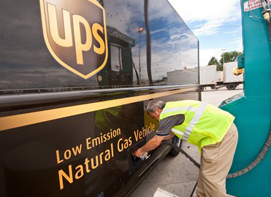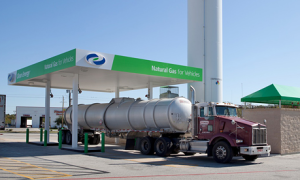Trucking Industry Is Set to Expand Its Use of Natural Gas
 Courtesy of The New York Times by Diane Cardwell and Clifford Krauss: In Ontario, Calif., a United Parcel Service truck equipped to use natural gas. U.P.S. plans to announce it will expand its natural gas truck fleet to 800 by the end of 2014.
Courtesy of The New York Times by Diane Cardwell and Clifford Krauss: In Ontario, Calif., a United Parcel Service truck equipped to use natural gas. U.P.S. plans to announce it will expand its natural gas truck fleet to 800 by the end of 2014.
Now the trucking industry, with its millions of 18-wheelers moving products like potato chips, underarm deodorant and copy paper around the country, is taking a leap forward in switching from petroleum to cleaner-burning natural gas. And if natural gas remains cheap, consumers may benefit again.
This month, Cummins, a leading engine manufacturer, began shipping big, new engines that make long runs on natural gas possible. A skeletal network of refueling stations at dozens of truck stops stands ready. Major shippers like Procter & Gamble, mindful of both fuel costs and green credentials, are turning to companies with natural gas trucks in their fleets.
And in the latest sign of how the momentum for natural gas in transportation is accelerating, United Parcel Service plans to announce in the next few days that it will expand its fleet of heavy 18-wheel vehicles running on liquefied natural gas, or L.N.G., to 800 by the end of 2014, from 112. The vehicles will use the new Cummins engines, produced under a joint venture with Westport Innovations.
 U.P.S., like the rest of the industry, still has a long way to go in the conversion, but the company hopes to make natural gas vehicles a majority of its new heavy truck acquisitions in two years.
U.P.S., like the rest of the industry, still has a long way to go in the conversion, but the company hopes to make natural gas vehicles a majority of its new heavy truck acquisitions in two years.
The company is benefiting from incentives provided by various states and the federal government, which offer tax credits and grants for installing natural gas fuel stations and using vehicles fueled by natural gas.
“By us doing this it will help pave the way and others will follow,” said Scott Wicker, chief sustainability officer at U.P.S.
“Moving into L.N.G. is a means to get us onto what we see as the bridging fuel of the future and off of oil,” he said. “It’s the right step for us, for our customers and for our planet.”
The move could also cut the country’s oil import bill. There are currently about eight million heavy and medium-weight trucks consuming three million barrels of oil a day while traveling the nation’s highways. That is nearly 15 percent of the total national daily consumption and the equivalent of three-fourths of the amount of oil imported from members of the Organization of the Petroleum Exporting Countries. Roughly two-thirds of the diesel used as transportation fuel nationwide feeds three million 18-wheelers, the main trucks hauling goods over long distances.
In the last four years, the natural gas shale drilling boom has produced a glut of inexpensive fuel, leading producers to argue that the country should wean its commercial and municipal transportation systems from a dependence on imported oil to domestically produced natural gas.
It is cheaper, saving truckers as much as $1.50 a gallon, and it burns cleaner, making it easier to meet emissions standards. The domestic fuel also provides some insulation from the volatile geopolitics that can drive up petroleum prices.
Still, manufacturers and fleet owners have been slow to switch, partly because natural gas vehicles can cost almost twice as much as conventional trucks and because only a few gasoline stations have the specialized equipment needed to dispense the fuel.
Now, as name-brand manufacturers and chains like Nike and Walmart have pressed for transportation of their goods by natural gas vehicles and companies like U.P.S., FedEx and Ryder System have started exploring the option, truck makers have begun bringing natural gas vehicles to the market. Major manufacturers, including Navistar and Volvo, have plans to offer long-haul natural gas vehicles.
Clean Energy Fuels — a company backed by the financier T. Boone Pickens and Chesapeake Energy — has peppered major routes with 70 stations, many at truck stops operated by Pilot Flying J. (The truck-stop company, whose chief executive is Jimmy Haslam, owner of the Cleveland Browns, is separately under investigation for potential rebate fraud.)
Clean Energy has plans to complete 30 to 50 more by the end of the year. Shell has an agreement to build refueling stations at as many as 100 TravelCenters of America and Petro Stopping Centers while ENN, a privately held Chinese company, hopes to build 500 filling stations as well.
That emerging network “really has changed the interplay between the shippers and the contracted carriers,” said Andrew J. Littlefair, Clean Energy’s chief executive. “The whole deal’s beginning to change.”
Though the network is growing rapidly, it has a long way to go. As of May 2012, only 53 L.N.G. fueling stations were in the United States, more than two-thirds concentrated in California, along with 1,047 compressed natural gas stations around the country, according to the Energy Department. In comparison, there were 157,000 fueling stations selling gasoline.
Vehicle use of natural gas in the United States is still negligible but it has been growing. Among fleets whose vehicles travel shorter routes, like transit buses, refuse haulers and delivery trucks, use of compressed natural gas is much further along. Last year, more than half of newly purchased garbage trucks ran on compressed natural gas.
The federal Energy Information Administration last year projected that if enough L.N.G. filling stations were built and economic conditions were right, sales of heavy-duty natural gas vehicles could increase to 275,000 in 2035, equivalent to 34 percent of new vehicle sales, from 860 in 2010. But estimates vary. Citigroup recently forecast that 30 percent of the heavy truck fleet would shift to natural gas by the end of the decade, but some in the transportation industry put that figure much lower.
L.N.G. trucking is slowly gaining traction internationally as well — especially in Canada and Europe — although conversion in the United States, where gas is relatively inexpensive, is expected to be faster. Trucking industry experts project that 5 percent of the European heavy trucking fleet could run on natural gas by 2015, rising to as much as 15 percent by 2020.
“Natural gas will be a part of that play in commercial vehicles, but our view is, it’s not going to replace diesel,” said Roe C. East, general manager of the natural gas business at Cummins. He added that natural gas could capture as much as 10 percent of the heavy-duty truck market in North America in the next five years.
One obstacle is cost. There are some tax incentives, and the Obama administration funneled stimulus money to various projects. ENN, the Chinese company, for instance, has teamed up with a small company now operating as Blu in Utah that used federal stimulus money to help open a natural gas fueling station in Salt Lake City in 2011.
But industry executives say that the incentives are not enough to get the system going and solve what Bill Logue, chief executive of the FedEx Freight Corporation, called the “chicken-and-egg dilemma” of which comes first, the trucks or the stations.
“We believe that public policy supporting the development of natural gas infrastructure is critical and should be prioritized,” he said in an e-mail message. “Individual drivers and private companies cannot realistically be expected to resolve the dilemma themselves.”
Another issue arises alongside the very appeal of the fuel: its low price.
Because natural gas is now in demand to meet so many different energy needs — including industrial electricity and home heating — prices could rise, as they have in recent months, especially if the Obama administration begins approving the fuel for export to countries where gas commands a much higher price, as some producers and lawmakers are pressing the Energy Department to do.
As U.P.S. executives explain it, the economics for the switch to natural gas are complex.
Prices for L.N.G. and diesel fuel vary around the country, so the company matches its L.N.G. trucks with states where it can get the lowest-cost gas on long-term contracts and the most generous grants. The rule of thumb, according to U.P.S., is that truck operators save 30 to 40 percent per mile driven on gas over diesel.
A big part of the equation is a 50-cent-per-gallon tax credit the federal government offers to companies that use L.N.G., but that is scheduled to expire at the end of the year.
(There are also federal taxes that work against gas use, including a 12.5 percent federal excise tax on new heavy trucks that is more onerous on L.N.G. vehicles because they are far more expensive.)
 “The economics are getting better and better to where it’s less of a leap of faith than it used to be,” said Kurt Kuehn, chief financial officer of U.P.S., although there is still risk because the upfront cost is so high. It still takes seven or eight years for the savings from replacing diesel with the cheaper fuel to cover that cost, he said. For many companies, that may prove too long to wait.
“The economics are getting better and better to where it’s less of a leap of faith than it used to be,” said Kurt Kuehn, chief financial officer of U.P.S., although there is still risk because the upfront cost is so high. It still takes seven or eight years for the savings from replacing diesel with the cheaper fuel to cover that cost, he said. For many companies, that may prove too long to wait.
But Clean Energy executives say that the margin between the fuel prices is so wide that the time for recouping the investment is shortening — perhaps to as little as one to three years.
Mr. Pickens, a Clean Energy board member who has been an advocate for switching the national trucking fleet to natural gas, said that even if the price of natural gas rose by roughly 50 percent, to $6 per thousand cubic feet, truck fleets would most likely still save money.
“Natural gas will always be less than diesel,” he said, “because the price of oil is set globally by OPEC and they have to have a price high enough to keep their social commitments and stay in power.”
Mr. Pickens predicted that a majority of the nation’s long-haul truck fleet would be fueled by natural gas in seven years because 70 percent of the 18-wheelers operate in defined regional areas, and a natural gas truck can drive 600 miles on a single fill-up.
“I promise you it will all fit together and the stations will be there,” he said.
Category: Featured, Fuel & Oil, General Update, Green










